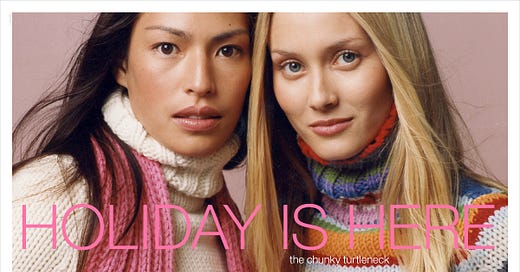It's Not Christmas Without the Gap Holiday Ads
How the magic and nostalgia of Gap's whimsical, elaborate holiday ads still speaks to Millennials.
The universal thing about fashion is that it can always be used as a temperature check for what’s going on in The Culture at large, right? Take the recent backlash to the very clueless and very boring LA Balenciaga show. A runway studded with stunt fashion and proliferated with Kardashians feels uninspired and stale in 2023. But it’s proof that audiences and consumers in general are over pandering and hungry for innovation and style that feels authentic and exciting.
Even if you’re not a fashion girlie, you can take a look around and rightfully deduce that we’re in kind of a bleh era. Platforms like TikTok have hyper-cycled through this and that style and throwback fashions so rapidly, it feels like every week there’s a new trend (it’s currently bows–which I think can be credited to the genius of Cool Girl Sandy Liang. I digress!)
I feel like most millennials I know dress fairly sleek and minimalist and androgynous. Ahem, as I drew attention to in my Hot Chessy Summer issue. But there’s a general spectrum between dressing like an adult toddler to Matrix extra to Goop in Great Expectations. So you would think that the masses would be flocking to Gap. But that’s only partially true. Millennials and Gen Z are only interested in vintage Gap.
Last year Vogue writer Liana Satenstein went long on our generation’s obsession with the holiday sweater, a coveted multicolored turtleneck Gap produced circa 2000. She chronicled how many a millennial scoured eBay and Poshmark to find the chunky knit and bring it into the current millennia where it is still rightfully very en-vogue. In fact, this whole rabbit hole was born out of nostalgia. The pink-twinged candy cane haze of the holidays being number one, and my stumble upon the amazing Instagram page, @gapplaylists, an archive of the eclectic in-store playlists lovingly curated and put back together by former employee Michael Bise.
So what’s happened in the 23 odd years since a viral holiday sweater debuted and Gap’s synonymous association with the holiday season disappeared? According to a recent Business of Fashion report, the retailer is struggling to get people through their doors. Obviously there’s many factors at play, including the death of the mall, but I’d also wager that a lot of Gap’s cultural cache is gone.
In Gaps heyday, somewhere between the mid 90s and the late aughts, the retailer was able to pull in record numbers, particularly around the holidays. Notably boosted by their iconic seasonal ads filled with tight choreography, Benetton-esque diversity, and beaming with color, style, and flair, their ads were a cultural institution all on their own. They were something to look forward to; something that heralded the season. They had directors like Sophia Coppola and Michel Gondry!
For a while I trolled the Internet for the Creative Director behind Gaps ads, their holiday ads specifically and a few names came up. The most mentioned being businessman Mickey Drexler, who served as CEO and grew the company in the ‘90s. Drexler is behind iconic campaigns like “Mellow Yellow” and “Dress You Up in My Love” and brought real life and vigor into the brand. He’s also behind its meteoric expansion and sister-brand Old Navy (for those of us in 5th grade who could not afford a $45 hoodie!)
Sadly Drexler was abruptly fired after slumping sales in the early aughts but his clear creative genius took him to Jenna Fuckin’ Lyons J. Crew. He’s continued to be an early adopter of cool and trend predictor and serves on the e-boards of Warby Parker, Outdoor Voices, and is pretty much responsible for getting J.Crew on Michelle Obama in her White House years.
Drexler moved onto bigger and better but the brand’s light continues to wax and wane through the years. Like most legacy retailers and big box stores they’ve struggled to adapt to the times. Once fledgling, aughts staples like Abercrombie have managed to make comebacks by reinventing themselves with a fresher, cleaner identity, but Gap already has that going for it. Instead of focusing on innovation or excitement around the brand or creating a fun, vibrant shopping experience for customers, Gap continues to falter.
I think millennials are eager to have a brand that speaks to them still specifically, whereas it feels like a lot of modern, moderately-priced brands have gone the way of Abercrombie, forcing Millennials to “get with the times” of Gen Z. I mean look at the comment section of this holiday ad from 2002, “Love Train.” We’re often chided for being annoyingly optimistic and twee and guess what, Gap is and always has been optimistic and twee! After all, its name is a reference to the “generation gap” and post Summer of ‘69 cultural attitudes. From a marketing standpoint, the answers seem so clear, so obvious. Show off why Gap was popular in the first place.
Frustratingly, Gap still sells the same fairly well made basics (heavy on the fairly–clothing quality in general being in the dumps is a subject for another day) as it used to, but could you see Spike Jonze directing one of their commercials, or an A-lister reaching for one of their button downs for the Oscars? Prob not. Til then, there’s always Goodwill, YouTube, and @gapplaylists.




